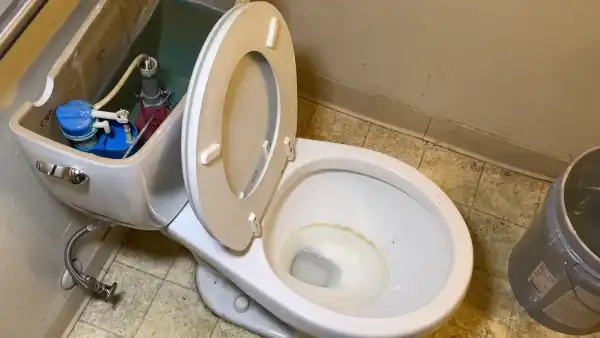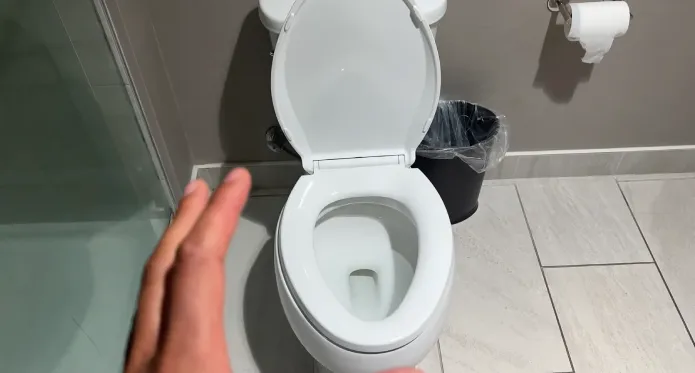Last Updated on October 17, 2023
You noticed that the water in your toilet continued to be cloudy and murky after flushing it. Cloudy water in the toilet bowl is unsightly and can indicate underlying issues.
Hard water buildup can occur over time and leave behind mineral deposits that make the water appear cloudy. Sediment and particles in the water can also contribute to cloudiness, as can air bubbles trapped in the plumbing system.
Also, bacterial growth or issues with the municipal water supply may be factors to consider when determining why your toilet water looks cloudy.
Our goal in this article is to explore the potential causes of cloudy toilet water and discuss practical solutions. So, keep reading to get the actual facts.
Why Your Toilet Water is Cloudy After Flushing: Possible Reasons

If you’ve noticed that your toilet water is cloudy, several possible reasons exist, such as:
- Hard water buildup
- Sediment and particles
- Air bubbles
- Bacterial growth
- Municipal water supply issues
1. Hard Water Buildup
Hard water, rich in calcium and magnesium, contains elevated levels of these minerals. When you flush your toilet, these minerals gradually build up inside the tank. They tend to cling to the walls and components of the tank over time.
As a result, when you flush again, some of these accumulated minerals disperse into the bowl, giving your toilet water a cloudy appearance.
The buildup of minerals causes cloudiness and can lead to other issues with your toilet. It can cause clogs or blockages in the pipes and valves connected to the tank.
2. Sediment and Particles
Particles, such as the water source or rusted pipes, can enter your plumbing system. When you flush, these particles, including sediment and tiny debris, can cause a cloudy appearance in your toilet water.
Sediment may come from rusted pipes that have deteriorated over time, releasing small particles into the water supply. Also, minerals naturally present in the water can also lead to sediment buildup. When these particles are suspended in the water, they appear cloudy or hazy.
3. Air Bubbles
Air bubbles in the toilet water can be caused by pressure fluctuations or a sudden rush of water. When there is a change in pressure, such as when you flush the toilet or turn on a nearby faucet, it can create air bubbles that get trapped in the water. These bubbles then rise to the surface and cause the water to appear cloudy.
Similarly, a sudden rush of water into the bowl can also create air bubbles, contributing to cloudiness. The air bubbles in your toilet water are generally temporary and cause concern.
4. Bacterial Growth
Bacterial growth in the toilet tank or bowl can also contribute to cloudy water. This occurs when bacteria, such as coliforms, multiply in stagnant water. These bacteria can enter the toilet through fecal matter or contaminated cleaning tools.
Once inside, they thrive in the warm and moist environment of the tank or bowl. They can cause cloudiness in the water as they multiply due to their presence and byproducts.
5. Municipal Water Supply Issues
City water supply issues can sometimes cause cloudiness in toilet water. If the water contains minerals or particles, it can affect the clarity of the water in your toilet bowl.
Municipal water supplies can face various challenges that may impact their quality. For example, an issue with the filtration system or disruptions in the distribution network can result in cloudy toilet water.
What to Do If Your Toilet Water is Cloudy?
If your toilet water appears cloudy after flushing, there are several steps you can take to address the issue.
STEP 1. Identify the Cause
Check if your toilet water is cloudy due to hard water, mold growth, excessive use of toilet cleaners, or worn-out fixtures like the flapper or fill valve.
STEP 2. Sanitize the Toilet
Having determined the cause of your cloudy toilet water, you should sanitize it to eliminate any bacteria or germs present or unpleasant smells. Ensure you’ve turned off the water supply valve and flushed the toilet to drain the tank and bowl.
Use a toilet cleaner designed for this purpose and apply generously to the bowl and tank surfaces. Allow the cleaner to sit for a few minutes, as indicated in the manufacturer’s instructions, ensuring it has enough time to eliminate any odor-causing agents effectively.
STEP 3. Remove Accumulated Deposits
To remove any accumulated deposits in the bowl, use a plastic scraper or an old toothbrush to scrub the areas with stains or buildup gently. The plastic scraper or toothbrush should be used with caution to avoid scratching the surface of the toilet bowl. Pay close attention to corners, under the rim, and other areas where deposits may have built up over time.
STEP 4. Clean the Toilet Tank
After letting the cleaning solution sit in the tank for a few minutes, rinse thoroughly with water. This is crucial in maintaining a clean and hygienic toilet tank. Make sure to reach all corners and crevices to remove any accumulated deposits or stains.
STEP 5. Monitor the Situation
Now flush your toilet again and keep an eye on the water quality in your toilet to see if it becomes clear. In some cases, cloudiness could indicate a more significant plumbing problem that requires professional assistance.
How do I make my toilet water clear?

If you’ve noticed that your toilet water is starting to look murky or discolored, you don’t need to hire a professional cleaner to get your toilet looking clear and sparkling again. One of the best things you can do is use vinegar as a natural and effective cleaning solution.
Vinegar is a fantastic household ingredient because it’s naturally antibacterial and free of harmful chemicals. It’s acidic, which can help break down and remove any minor lime or calcium deposits in your toilet.
All you need to do is pour a couple of cups of vinegar in your toilet tank and let it sit for an hour or so, then give your toilet a good scrub and flush. It’s simple, effective, and will leave your toilet looking as good as new!
Clear and Pleasant: Swiftly Addressing Cloudy Toilet Water
Cloudy toilet water is a problem that requires swift attention to identify and fix. The causes of cloudy toilet water can range from hard water buildup to bacterial contamination, making it essential to identify the underlying cause and take appropriate measures to resolve it.
We’ve seen that the steps to fix cloudy toilet water include turning off the water supply, sanitizing the toilet, removing accumulated deposits, cleaning the toilet tank, and monitoring the situation afterward.
If you’ve tried these steps and the problem persists, it’s time to call in a professional plumber to take a closer look. By taking prompt action, you can ensure that your toilet water remains clear and pleasant.

